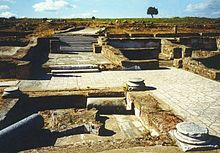Villa of Pisões
The ruins of the Roman villa of Pisões lie immediately west of Beja in the Alentejo in Portugal . The villa rustica was discovered by chance in 1967 during agricultural work. There are more than 2000 year old mosaics and the remains of the water supply.
The villa rustica
The villa of Pisões has typical Roman architecture and, like the villa of São Cucufate, was only built on three sides around the no longer closed inner courtyard with colonnade.
The ruins belonged to a farm that supplied the Roman city of Pax Julia (Beja) with food from the 1st to 4th centuries. Gaius Atilius Cordo was one of its owners, whose name was found on an altar stone. The division of the pars urbana , the living area of the owners, is clearly visible . The mosaics with their geometric and naturalistic motifs can be found in the most important of the more than 40 rooms of the pars urbana . There is also a well-preserved hypocaust (the underground structure for heating) the thermal baths and an Olympic-sized swimming pool. In the pars rustica and the pars fructuaria , the workers' accommodation and the storage rooms for the grain can be seen.
The villa is a vivid example of the connection between a Roman villa and an associated water reservoir. The dam is immediately north of the villa. At São Cucufate there is the Cuba dam a little further away .
The dam
The non-reinforced dam is 58 m long, up to 4.3 m high and over 3 m thick and belongs to the type of gravity dams. The masonry has a special feature that makes the dam more stable. The bricks are wedged against each other. The gaps were closed with small stones. As on Muro da Prega , the walls were built in layers. The cladding, which is regularly placed from larger, roughly cut blocks, gives a good impression of the outside. The inflow to the water basin and the bathroom of the villa could be regulated via a drain, which is located at the foot of the dam. It is lined with bricks.
The dam blocks a hydrographic basin that reaches as far as Beja and covers 18.6 km². It was built on the site that would provide a natural runoff in the event of a flood. A length of approx. 340 m, a storage area of 31,300 m² (around four soccer fields) and a storage volume of 38,000 m³ are assumed for the filled reservoir. The field name Pisões is associated with mills that powered machines for making wool at a time when the dam was no longer in use.
literature
- Thomas G. Schattner (Ed.): Archaeological guide through Portugal (= cultural history of the ancient world . Vol. 74). Philipp von Zabern, Mainz 1998, ISBN 3-8053-2313-1 , p. 184.
Web links
Coordinates: 37 ° 59 ′ 51 ″ N , 7 ° 56 ′ 56 ″ W.

